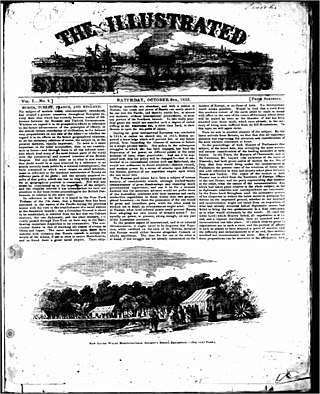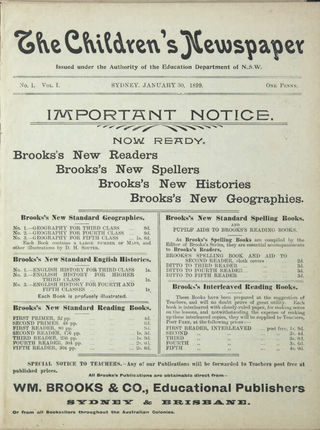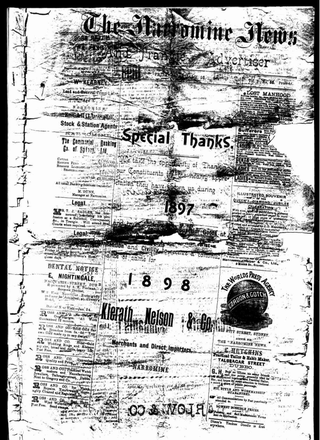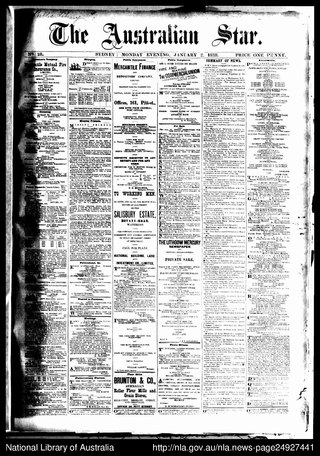
Meie Kodu (English: Our Home) is an Estonian language newspaper published in Sydney, New South Wales, Australia, from 1949. [1] [2]

Meie Kodu (English: Our Home) is an Estonian language newspaper published in Sydney, New South Wales, Australia, from 1949. [1] [2]
Meie Kodu was first published on August 14, 1949, by Estonian immigrants. [3] The Estonian community in Australia in 1949 was estimated to be approximately 3,000 people. [4] Most Estonians who arrived in Australia following the end of World War Two came as 'Displaced Persons' or refugees who were leaving their homeland following the imposition of Soviet rule in 1944.
Typical of other non-English language newspapers in Australia, Meie Kodu played an important role in keeping newly arrived Estonians aware of the domestic situation in Estonia and also played an important role in providing information useful for daily living in their adopted home of Australia - "...to acquaint readers with the life of Estonians here, their working conditions as well as their social activities, their political status and their hopes, in order to lighten our countrymen’s task of settling to a new life”. [4] The 'information useful for daily living in their adopted home of Australia' has been replaced by reports on Estonian community activities in all States and Territories of Australia.
The paper was published initially as a weekly but started fortnightly publication from its 16 January 2013 issue. During its 70th year in 2019, Meie Kodu officially ceased publication. [5]
The paper has been digitised as part of the Australian Newspapers Digitisation Program. [6]

The Sydney Gazette and New South Wales Advertiser was the first newspaper printed in Australia, running from 5 March 1803 until 20 October 1842. It was a semi-official publication of the government of New South Wales, authorised by Governor Philip King and printed by George Howe. On 14 October 1824, under the editorship of Robert Howe, it ceased to be censored by the colonial government.
Lia Looveer BEM was an Estonian émigré political activist in Australia.

The Sydney Mail was an Australian magazine published weekly in Sydney. It was the weekly edition of The Sydney Morning Herald newspaper and ran from 1860 to 1938.

The Sun was an Australian afternoon tabloid newspaper, first published in Sydney under that name in 1910.

The Colonist was a weekly English-language tabloid newspaper published in Sydney from 1835 to 1840.

Bell's Life in Sydney and Sporting Reviewer, also published as Bell’s Life in Sydney and Sporting Chronicle, was a weekly English language newspaper published in Sydney, New South Wales, Australia between 1845 and 1870.

The Illustrated Sydney News was a monthly English language newspaper published in Sydney, New South Wales, Australia.

The Singleton Argus, also published as The Singleton Argus and Upper Hunter General Advocate, is a semiweekly English language newspaper published in Singleton, New South Wales, Australia since 1874.

The Children's Newspaper was a monthly English language newspaper published from 1899–1900 in New South Wales, Australia. It was also known as The Children's Newspaper: a monthly journal for young folks and The Australian Children's Newspaper.

Australian Town and Country Journal was a weekly English language broadsheet newspaper published in Sydney, New South Wales, from 1870 to 1919. The paper was founded by Samuel Bennett with his intention for it to be "valuable to everybody for its great amount of useful and reliable information".

The Monitor was a biweekly English language newspaper published in Sydney, New South Wales and founded in 1826. It is one of the earlier newspapers in the colony commencing publication twenty three years after the Sydney Gazette, the first paper to appear in 1803, and more than seventy years before the federation of Australia. The Monitor changed name several times, subsequently being known as The Sydney Monitor, and in June 1838 Francis O'Brien and Edwyn Henry Statham introduced themselves as the new editors of the re-branded Sydney Monitor and Commercial Advertiser.
Our Home may refer to:

The Catholic Weekly is an English language newspaper currently published in Sydney, Australia. It is published in tabloid format. Throughout its history, it has also been published as The Freeman's Journal and Catholic Freeman's Journal.

The Labor News was a weekly English-language broadsheet newspaper published in Sydney, Australia. It was later absorbed by the Labor Daily newspaper.

The Mirror of Australia was an English-language newspaper published in Sydney, Australia from 1915 to 1917. It later merged with the Globe and Sunday Times War Pictorial and continued under the masthead of Mirror.

Direct Action was an English-language newspaper published in Sydney, New South Wales, Australia. It was published in tabloid format.

The Narromine News was a newspaper published bi-weekly in Narromine, New South Wales, Australia. It was published as the Narromine News and Trangie Advocate from 1896 to 1979 when its name was changed to the Narromine News.

The South Coast Times and Wollongong Argus, also previously published as the Wollongong Argus, and later as the South Coast Times, was a weekly English language newspaper published in Wollongong, New South Wales, Australia from 1900 to 1959.

Gerd Neggo was an Estonian dancer, dance teacher and choreographer. She studied the musical response methods of É. Jaques-Dalcroze, trained under Rudolf von Laban in Hamburg, Germany, and in 1924 established her own dance studio at Tallinn, Estonia, and promoted modern dance and mime based on classical ballet. During the Soviet occupation of Estonia, she and her husband Paul Olak migrated to Sweden. Her contributions to the cultural heritage of Estonia, as the founder of modern dance and mime in her country, is recognised via a scholarship, awarded annually since 2011.

The Australian Star was a daily English-language newspaper published in Sydney, New South Wales, Australia, from 1887 to 1909. It was published as The Star, also known as The Star: the Australian Evening Daily, until 1910 and then renamed The Sun, which continued publication until 1988.